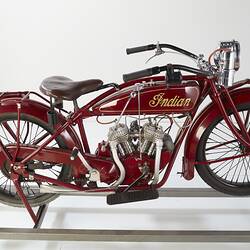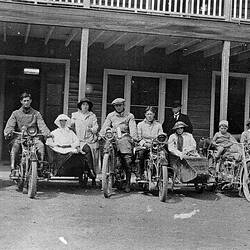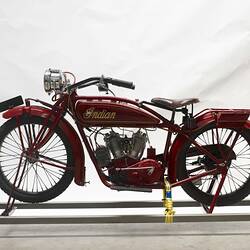Summary
'Indian' motor cycles were produced by the Hendee Manufacturing Company at Springfield, Massachusetts, USA in what was at one time the largest motorcyle factory in the world. Founded by George M. Hendee, the company originally made bicycles before introducing the first 'Indian' motor cycle in 1901, designed by Oscar Hedstrom. Indian motor cycles achieved early racing success before the First World War in America, Britain, Europe and Australia and were for many years among the most advanced motor cycles in volume production. The first Australian 'Tourist Trophy' (T.T) motor cycle race was held near Goulburn, NSW in April 1913 and was won by Victorian rider Harry Jenkins on a 7 h.p Indian. Originally built as singles, the company introduced its first V-twin engined bike in 1905, being one of the first manufacturers to produce the type commercially.
From 1915, Charlie Gustafson was the company's chief designer. He established the side-valve engine as the most popular American motor cycle powerplant and designed the famous 15-18 horsepower, 986cc 'Powerplus' model launched in 1916. Hendee were keen to establish the performance credentials of the new "Powerplus' in Australia and sent well-known works rider Erwin. G 'Cannonball' Baker to Australia in 1916 to establish records which he did in January 1916 by completing a world record 1027 miles in 24 hours on an Indian 'Powerplus' at Mortlake, Victoria. Sisters Adeline and Augusta Van Buren became the first women to complete a trans-continental crossing of the United States from New York to California on a pair of Indian Powerplus machines in 1916. They wanted to prove the point that women could be motor cycle despatch riders if the United States went to war. When the United States entered the First World War in 1917, almost the entire production of Powerplus motorcycles were were turned over to military and government users. The Powerplus continued in production until 1924 but was re-named the Standard in 1922.
The Museum's engine is a sectioned display example of the Indian Powerplus four-stroke petrol motor cycle engine, a two-cylinder V-type with aluminium crankcase. Fitted with Schleber carburettor and Dixie magneto. This sectioned Powerplus engine was acquired for display from the local Hendee agents the Rhodes Motor Cycle Co. Pty Ltd by the Museum in 1925. This firm was located at 109-111-113 Russell Street, Melbourne at the time. Previously the Hendee Manufacturing Company had operated its Australasian branch from this address. The engine had previously been used for promotional display purposes by the Rhodes Motor Cycle Company. In a letter dated 9 February 1925, Mr John H. Rhodes wrote to the Museum that the 'sectionized' engine would be forwarded " ...as soon as it is returned to us from the country centre where it has recently been on show." The Museum had been seeking an example of an Indian engine for some years having first made enquiries with the Hendee agency in 1915.
More Information
-
Collection Names
-
Collecting Areas
-
Acquisition Information
Donation from Hendee Manufacturing Co, 05 Jun 1925
-
Manufacturer
Hendee Manufacturing Co, Springfield, Massachusetts, United States of America, 1916
-
Agent
Rhodes Motorcycle Co, 109-113 Russell Street, Melbourne, Greater Melbourne, Victoria, Australia, 1925
-
Classification
-
Category
-
Discipline
-
Type of item
-
Overall Dimensions
390 mm (Length), 320 mm (Width), 530 mm (Height)
-
Keywords
Internal Combustion Engines, Motor Cycle Engines, Motor Cycles



